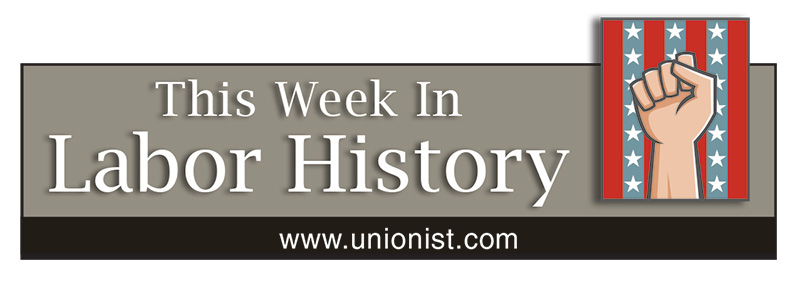This week in labor history: June 7-13

JUNE 7
1904 – Militia sent to Cripple Creek, Colo., to suppress Western Federation of Miners strike.
1913 – Sole performance of Pageant of the Paterson (N.J.) Strike, created and performed by 1,000 mill workers from the silk industry strike, New York City.
1929 – Striking textile workers battle police in Gastonia, N.C. Police Chief O.F. Aderholt is accidentally killed by one of his own officers. Six strike leaders are convicted of “conspiracy to murder” and are sentenced to jail for five to 20 years.
1979 – Founding convention of the United Food and Commercial Workers. The merger brought together the Retail Clerks Int’l Union and the Amalgamated Meatcutters and Butcher Workmen of North America.
2006 – The United Steelworkers and the Sierra Club announce the formation of a strategic alliance to pursue a joint public policy agenda under the banner of Good Jobs, A Clean Environment, and A Safer World.
JUNE 8
1904 – A battle between the militia and striking miners at Dunnville, Colo., ended with six union members dead and 15 taken prisoner. Seventy-nine of the strikers were deported to Kansas two days later.
1917 – Spectator Mine disaster kills 168, Butte, Mont.
1966 – Some 35,000 members of the Machinists union begin what is to become a 43-day strike — the largest in airline history — against five carriers. The mechanics and other ground service workers wanted to share in the airlines’ substantial profits.
1852 – The earliest recorded strike by Chinese immigrants to the U.S. occurred when stonemasons — who were brought to San Francisco to build the three-story Parrott granite building made from Chinese prefabricated blocks — struck for higher pay.
1971 – New York City drawbridge tenders, in a dispute with the state over pension issues, leave a dozen bridges open, snarling traffic in what the Daily News described as “the biggest traffic snafu in the city’s history.”
JUNE 9
1865 – Helen Marot is born in Philadelphia to a wealthy family. She went on to organize the Bookkeepers, Stenographers and Accountants Union in New York, and to organize and lead the city’s 1909-1910 Shirtwaist Strike. In 1912, she was a member of a commission investigating the Triangle Shirtwaist Factory fire.
JUNE 10
1937 – The mayor of Monroe, Mich. organizes a vigilante mob of 1,400 armed with baseball bats and tear gas to break the organizing picket line of 200 striking workers at Newton Steel. The line is broken; eight are injured and hospitalized. Sixteen workers’ cars were vandalized, five cars overturned, and eight more were dumped into the River Raisin.
1946 – U.S. Supreme Court rules in Anderson v. Mt. Clemens Pottery Co. that preliminary work activities, where controlled by the employer and performed entirely for the employer’s benefit, are properly included as working time. The decision is known as the “portal to portal case.”
1963 – President Kennedy signs a law mandating equal pay to women who are performing the same jobs as men (Equal Pay Act).
JUNE 11
1894 – Representatives from the AFL, Knights of Labor, populists, railroad brotherhoods and other trade unions hold a unity conference in St. Louis but fail to overcome their differences.
1913 – Police shoot at maritime workers striking United Fruit Co. in New Orleans; one killed, two wounded.
1969 – John L. Lewis dies. A legendary figure, he was president of the United Mine Workers from 1920 to 1960 and a driving force behind the formation of the Congress of Industrial Organizations.
JUNE 12
1904 – Fifty thousand members of the Amalgamated Meat Cutters and Butcher Workmen employed in meatpacking plants walk off their jobs; demands include equalization of wages and conditions throughout U.S. plants.
1945 – The U.S. Supreme Court invalidates two sections of a Florida law. One required state licensing of paid union business agents, the other required registration with the state of all unions and their officers.
1981 – Major League Baseball strike begins, forces cancellation of 713 games. Most observers blamed team owners for the strike; they were trying to recover from a court decision favoring the players on free agency.
JUNE 13
1884 – Congress creates a Bureau of Labor, under the Interior Department. It later became independent as a Department of Labor without executive status in the Department of Commerce and Labor. In 1913, it became the Department of Labor we know today.
1926 – Tony Mazzocchi born in Brooklyn, N.Y. An activist and officer in the Oil, Chemical and Atomic Workers union, he was a mentor to Karen Silkwood, a founder of the Labor Party, and a prime mover behind the 1970 passage of the Occupational Safety and Health Act.
(Compiled by David Prosten, founder of Union Communication Services)


Leave a Reply